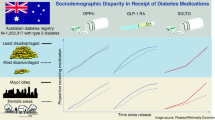Abstract
Background
Morbid obesity is associated with serious health and social consequences, high medical costs and is increasing in the USA, particularly among rural, socioeconomically disadvantaged populations. Bariatric surgery more often provides significant long-term weight loss than traditional weight loss treatments. We examined the likelihood of bariatric surgery among morbidly obese patients across rural/urban locales, racial/ethnic groups, insurance categories, socioeconomic, and comorbidity levels.
Methods
We examined 159,116 records representing 774,000 patients with morbid obesity from the 2006 Nationwide Inpatient Sample. We determined the likelihood, expressed in odds ratios, of bariatric surgery associated with each patient characteristic using survey-weighted univariate logistic regression. We also performed multivariate logistic regression, assuming all patient factors were independent.
Results
After adjusting for patient-level characteristics, the most rural residents were 23% less likely to receive bariatric surgery than urban residents. Other demographic features associated with significantly lower odds ratios for bariatric surgery included minority status, male gender, lower income, older age, non-private insurance status, and higher comorbidity. Rural-dwelling patients who are non-white, male, poorer, older, sicker, and non-privately insured almost never received bariatric surgery (OR = 0.0089).
Conclusions
Though obesity is more prevalent among middle-aged, rural, economically disadvantaged, and racial/ethnic minority populations, these patients are unlikely to access bariatric surgery. Because obesity is a leading cause of preventable morbidity and mortality in the USA, effective treatments should be made available to all patients who might benefit. Current Medicare/Medicaid policies that reimburse only high volume centers may effectively deny rural residents who rely on these insurance programs for bariatric surgery.

Similar content being viewed by others
References
Arterburn DE, Maciejewski ML, Tsevat J. Impact of morbid obesity on medical expenditures in adults. Int J Obes (Lond). 2005;29:334–9.
Ogden CL, Carroll MD, Curtin LR, et al. Prevalence of overweight and obesity in the United States, 1999–2004. JAMA. 2006;295:1549–55.
Jackson JE, Doescher MP, Jerant AF, et al. A national study of obesity prevalence and trends by type of rural county. J Rural Health. 2005;21:140–8.
Glenny AM, O'Meara S, Melville A, et al. The treatment and prevention of obesity: a systematic review of the literature. Int J Obes Relat Metab Disord. 1997;21:715–37.
McTigue KM, Harris R, Hemphill B, et al. Screening and interventions for obesity in adults: summary of the evidence for the U.S. preventive services task force. Ann Intern Med. 2003;139:933–49.
Grunstein RR, Stenlof K, Hedner JA, et al. Two year reduction in sleep apnea symptoms and associated diabetes incidence after weight loss in severe obesity. Sleep. 2007;30:703–10.
Vogel JA, Franklin BA, Zalesin KC, et al. Reduction in predicted coronary heart disease risk after substantial weight reduction after bariatric surgery. Am J Cardiol. 2007;99:222–6.
Sjostrom L, Lindroos AK, Peltonen M, et al. Lifestyle, diabetes, and cardiovascular risk factors 10 years after bariatric surgery. N Engl J Med. 2004;351:2683–93.
Pories WJ, Swanson MS, MacDonald KG, et al. Who would have thought it? An operation proves to be the most effective therapy for adult-onset diabetes mellitus. Ann Surg. 1995;222:339–50. discussion 50-2.
Buchwald H, Avidor Y, Braunwald E, et al. Bariatric surgery: a systematic review and meta-analysis. JAMA. 2004;292:1724–37.
Sjostrom L, Narbro K, Sjostrom CD, et al. Effects of bariatric surgery on mortality in Swedish obese subjects. N Engl J Med. 2007;357:741–52.
Poulose BK, Holzman MD, Zhu Y, et al. National variations in morbid obesity and bariatric surgery use. J Am Coll Surg. 2005;201:77–84.
Shinogle JA, Owings MF, Kozak LJ. Gastric bypass as treatment for obesity: trends, characteristics, and complications. Obes Res. 2005;13:2202–9.
Felix-Aaron K, Moy E, Kang M, et al. Variation in quality of men's health care by race/ethnicity and social class. Med Care. 2005;43:I72–81.
Santry HP, Gillen DL, Lauderdale DS. Trends in bariatric surgical procedures. JAMA. 2005;294:1909–17.
Livingston EH, Ko CY. Socioeconomic characteristics of the population eligible for obesity surgery. Surgery. 2004;135:288–96.
Deyo RA, Cherkin DC, Ciol MA. Adapting a clinical comorbidity index for use with ICD-9-CM administrative databases. J Clin Epidemiol. 1992;45:613–19.
Ayanian JZ, Weissman JS, Chasan-Taber S, et al. Quality of care by race and gender for congestive heart failure and pneumonia. Med Care. 1999;37:1260–9.
Epstein AM, Weissman JS, Schneider EC, et al. Race and gender disparities in rates of cardiac revascularization: do they reflect appropriate use of procedures or problems in quality of care? Med Care. 2003;41:1240–55.
Rashid MN, Fuentes F, Touchon RC, et al. Obesity and the risk for cardiovascular disease. Prev Cardiol. 2003;6:42–7.
Poirier P, Giles TD, Bray GA, et al. Obesity and cardiovascular disease: pathophysiology, evaluation, and effect of weight loss: an update of the 1997 American Heart Association Scientific Statement on Obesity and Heart Disease from the Obesity Committee of the Council on Nutrition, Physical Activity, and Metabolism. Circulation. 2006;113:898–918.
Trend table 30: Leading causes of death. Hyattsville, MD 20782 National Center for Health Statistics 2008.
Department of Health and Human Services (2008) Medicare proposes revised coverage policy for bariatric surgery as a diabetes treatment. In: Centers for Medicare and Medicaid Services. Press Releases, Baltimore
Author information
Authors and Affiliations
Corresponding author
Additional information
The research reported here was supported by the Veterans Rural Health Resource Center—Eastern Region, Veterans Administration Office of Rural Health. The views expressed in this article do not necessarily represent the views of the Department of Veterans Affairs or of the US government.
Rights and permissions
About this article
Cite this article
Wallace, A.E., Young-Xu, Y., Hartley, D. et al. Racial, Socioeconomic, and Rural–Urban Disparities in Obesity-Related Bariatric Surgery. OBES SURG 20, 1354–1360 (2010). https://doi.org/10.1007/s11695-009-0054-x
Received:
Accepted:
Published:
Issue Date:
DOI: https://doi.org/10.1007/s11695-009-0054-x




